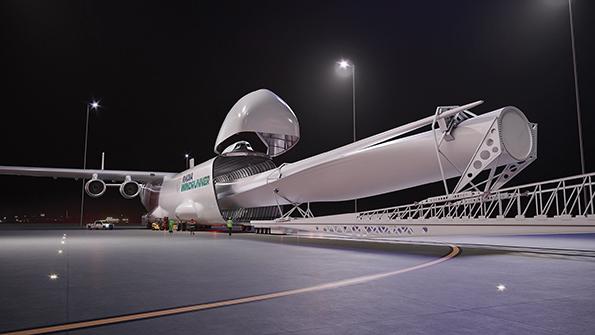
The WindRunner is designed to transport wind turbine blades up to 105 m long.
U.S. startup Radia has announced its first supplier partners on development of the WindRunner, planned to be the world’s largest aircraft and designed to fly giant wind turbine blades directly to onshore wind farms.
Spanish aerostructures manufacturer Aernnova, a Tier 1 supplier to Airbus and Embraer, will partner with Radia on development of the WindRunner’s wing and engine pylons. Italian aerospace giant Leonardo will provide engineering support for design of the 108.5-m-long (356-ft.) fuselage.
- Aernnova will develop the WindRunner’s wing and engine pylons
- Leonardo will develop the fuselage
U.S. company AFuzion, a supplier of aviation safety-critical engineering services, will provide consulting, training and support for certification of the WindRunner.
Radia has not released a target date for certification of the WindRunner but plans to operate the aircraft to deliver turbine blades before the end of the decade.
Founded in 2016, the company has been working on the WindRunner for about six years. “The Radia team has been dealing with requirements definition, conceptual design, finite element modeling, computational fluid dynamics and wind tunnel testing, but doing all of this in a design philosophy we’ve called ‘minimum viable aircraft,’ focused on looking at suppliers that have existing Tier 1 components and processes,” founder and CEO Mark Lundstrom says.
“We’ve been working with the supply chain for years to understand what those components and capabilities are,” he adds. “Our team has done a fantastic job designing the aircraft around those constraints, and now we’re in the process of bringing those suppliers with whom we have been working for some time into the supply chain leading up to PDR [preliminary design review].”
With a fuselage more than 32 m longer than the Boeing 747-8’s, the WindRunner is designed to carry turbine blades up to 105 m long directly to wind farm sites, landing on semi-prepared runways as short as 1,800 m. Only ships can transport such large blades to offshore wind turbines now. Radia’s objective is to overcome the logistical barriers to the expansion of onshore wind energy with what it calls GigaWind.
“WindRunner is an opportunity for the aerospace industry to have a decisive impact on climate change, diversify into the energy industry and seize an enormous market opportunity,” Lundstrom says. “It’s perhaps the first time that aerospace suppliers can be involved in an industry that’s completely different from what they’re typically involved with,” he says, noting that energy is generally less cyclical than aviation.
“As a veteran of the wind turbine industry, I can attest to the urgent need for the solution that WindRunner represents,” says Aernnova CEO Ricardo Chocarro, who was previously CEO of onshore business for Spanish-German wind turbine manufacturer Siemens Gamesa.
Aernnova is engaged with other startups, supplying aerostructures to electric aircraft developers Heart Aerospace and Lilium, while Leonardo is building the fuselage for Vertical Aerospace’s electric air taxi. “The WindRunner initiative is an interesting example of how the aerospace industry continues to provide a key contribution to sustainability,” says Stefano Bortoli, managing director of Leonardo’s aerostructures division.
“These large turbines are just much more efficient,” Lundstrom says, pointing to a study conducted for Radia by Princeton University researchers on the impact of GigaWind on the U.S. electrical grid. This concluded that bigger turbines could reduce CO2 emissions from the grid 15-31% by 2050. “That’s equivalent to the possibility of taking 10% of CO2 out of the world.”
Radia’s solution to the challenge of transporting such large turbine blades is a purpose-designed aircraft with the same 80-m wingspan as an Airbus A380 but optimized for fuselage length and volume rather than payload weight. The WindRunner has about half the maximum payload of the 747-8 freighter but more than 11 times the volume. The wing is composite, but the fuselage is metallic.
“We’re not having unrealistic expectations about the timing,” Lundstrom says. “We have worked with the suppliers on an aggressive but also typical time frame for the major milestones of PDR, [critical design review] and first flight. We anticipate first flight in the next few years and having a vibrant business going before the end of this decade delivering turbines.”





